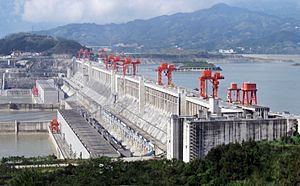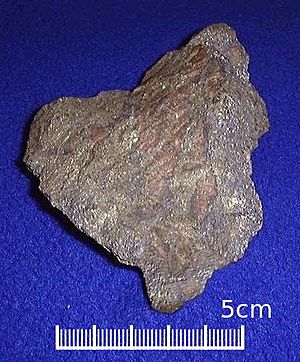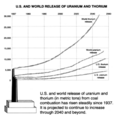Non-renewable resource facts for kids
Imagine something you use that takes millions of years to form, but we use it up really fast. That's a non-renewable resource! It's a natural resource that nature can't make fast enough to replace what we use. Once it's gone, it's gone for a very long time.
Things like fossil fuels (like coal, petroleum or oil, and natural gas) are non-renewable. So are materials for nuclear power (like uranium). Even precious metals like gold, silver, and iron are non-renewable. They are sometimes called exhaustible resources because they can run out.
On the other hand, things like wood from trees can be a renewable resource if we plant new trees as we cut them down.
Contents
Earth's Minerals and Metals
Minerals and metal ores found in the Earth are non-renewable resources. Metals are found in huge amounts deep inside the Earth's crust. However, we can only dig them up where they are found in large, easy-to-reach pockets.
These pockets are formed by natural processes like heat, pressure, and changes in the Earth over millions of years. This means that once we dig up these pockets of metal, they won't form again in our lifetime. Some rare earth minerals and elements are even harder to find. They are very important for making things like electronics.
Fossil Fuels
Natural resources like coal, petroleum (crude oil), and natural gas are called fossil fuels. They take thousands to millions of years to form naturally from ancient plants and animals. We use them much faster than nature can make them.
Scientists believe that eventually, it will become too expensive to dig up and use fossil fuels. When that happens, people will need to rely more on other energy sources. These include renewable energy sources like solar power or wind power.
Many people criticize our modern use of fossil fuels. They are not renewable, and they also contribute to climate change.
Nuclear Fuels
Uranium is a key material used for nuclear power. It is also a non-renewable resource. Once the uranium is used in a nuclear power plant, it becomes radioactive waste. This waste needs to be stored safely for hundreds of years.
Some special types of nuclear reactors, called breeder reactors, can actually create more nuclear fuel than they use. Some experts consider the fuel from these reactors to be renewable. However, most nuclear power plants today use uranium in a way that makes it a non-renewable resource.
Land Surface
The land we live on can be seen as both renewable and non-renewable. We can reuse land for different purposes, like building or farming. But we can't create new land on Earth.
Renewable Resources

Natural resources that can be replaced by natural processes are called renewable resources. These include things like water, forests, plants, and animals. They are renewable as long as we protect and manage them carefully.
For example, sustainable agriculture means farming in a way that keeps the soil healthy. It also protects plants and animals for the future. If we catch too many fish (called overfishing), it can harm the ocean's ecosystems. This can even make some fish species disappear.
When we make products, we often create a lot of waste. Recycling helps turn valuable materials that would be thrown away into new resources. This is a great way to reuse things.
Energy from the sun, wind, waves, and geothermal energy are all based on renewable resources. These energy sources are practically endless. They will not run out, unlike non-renewable resources.
Images for kids
See also
 In Spanish: Recurso no renovable para niños
In Spanish: Recurso no renovable para niños






